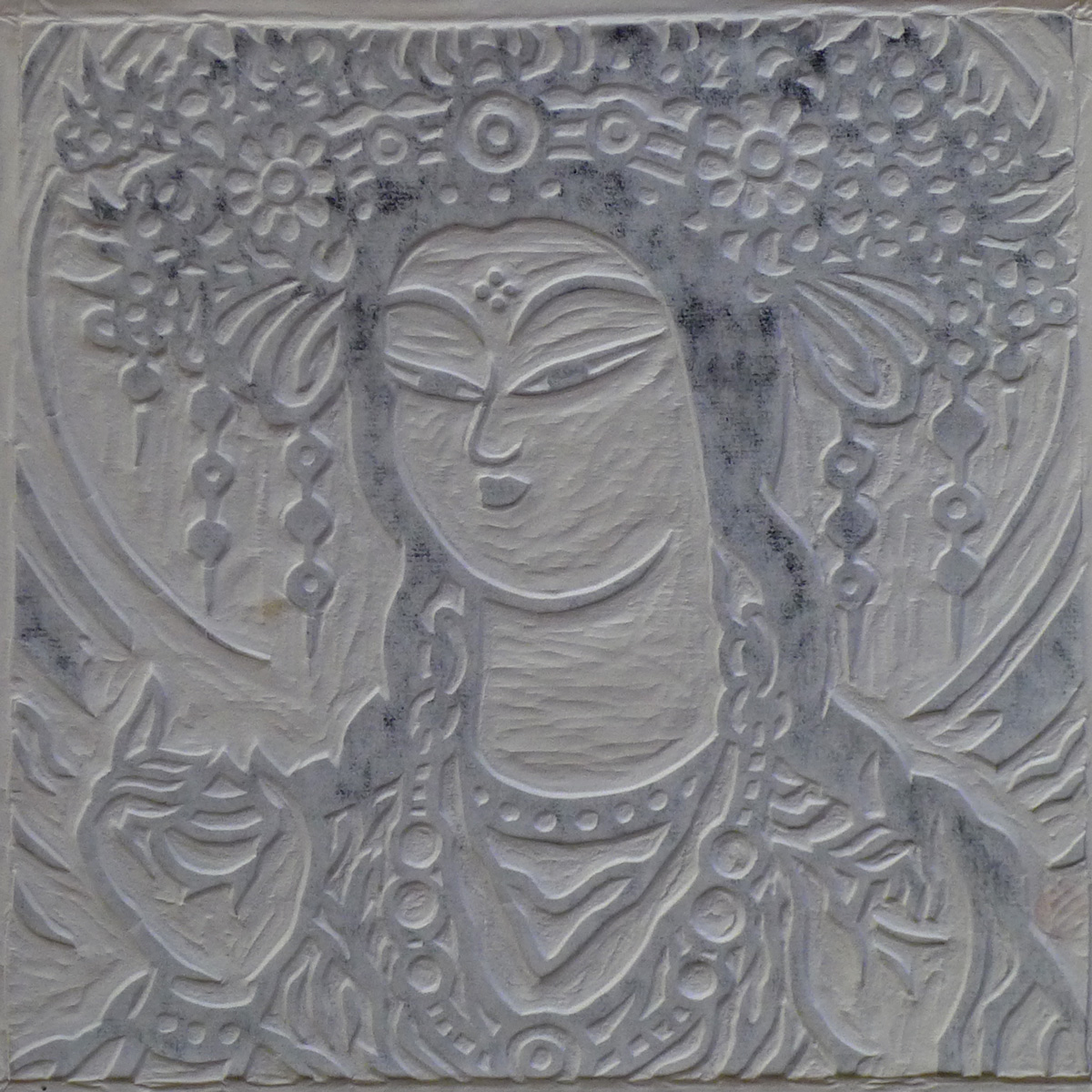About This Print
Depicting the Buddhist goddess Kisshōten, goddess of fertility, wealth, and beauty. In her left hand she holds the "wish-granting jewel" while her right hand is held in the position of the Karana Mudra to expel demons.
This is one of over a dozen prints depicting this goddess designed by Sasajima. Sasajima used his takuzuri process, forcing damp paper into the grooves of a carved woodblock under pressure, to give this print a dynamic three-dimensional effect. He has hand-applied black ink directly on the raised areas of the print.
Kisshōten 吉祥天 (also read Kichijouten)
Source: JAANUS (Japanese Architecture and Art Net Users System) http://www.aisf.or.jp/~jaanus/
Also called Kichijoutennyo 吉祥天女 or Kudokuten 功徳天 (Sk: Sri Laksmi, Mahasri, Mahadevi). Originally an Indian (Brahman) goddess of fertility, wealth, and beauty, who was linked to Kubera, the Hindu god of the North, and Vishnu the Lord of Creation. As Vishnu's chief consort, Kichijouten was absorbed later into popular Buddhism in China and Japan. In the KONKOUMYOU SAISHOUOUKYOU 金光明最勝王経 (The Sutra of the Sovereign Kings of the Golden light), she is associated with wealth and virtue. Japanese belief in Kichijouten was widespread in the Nara period, and her images, such as the sculptures at Toudaiji 東大寺 (746), Saidaiji 西大寺, Houryuuji 法隆寺 (748), and the painted portrait at Yakushiji 薬師寺 (ca.771), were worshipped as a principal image at the kisshou keka 吉祥悔過, or New Year's ceremony for welcoming good luck and sweeping out bad. In the Matrix mandala Taizoukai mandara 胎蔵界曼荼羅, Kichijouten appears as an attendant of Senju Kannon 千手観音, and the DARANI SHUUKYOU 陀羅尼集経 (Sutra describes a Kichijouten mandara 吉祥天曼荼羅) which was used in an Esoteric Buddhist ritual to promote earthly happiness and welfare. Kichijouten is usually represented as a beautiful Tang period court lady, wearing a richly embroidered gown and an elaborately jewelled head-dress. She is distinguished from Benzaiten 弁才天, with whom she is often confused, by the wish-granting jewel nyoi houju 如意宝珠 held in her left hand, and the lotus in her right. She also makes the gesture (mudra) of charity yogan-in 与願印 with her palm open and facing downwards. The 12c sculpture at Joururiji 浄瑠璃寺 in Kyoto, is typical of this latter type. Kichijouten was occasionally regarded as a sister of Kariteimo 訶梨帝母, the wife of Bishamonten 毘沙門天, and the mother of Zennishi douji 善膩師童子, and was represented together with the latter two deities.
Print Details
| IHL Catalog | #1404 |
| Title | Kisshōten V 吉祥天 V |
| Series | |
| Artist | Sasajima Kihei (1906-1993) |
| Signature | K. Sasajima in pencil by artist |
| Seal of the Artist |  |
| Publication Date | 1980 (71 of 100) |
| Publisher | the artist |
| Carver | self-carved |
| Impression | excellent |
| Colors | excellent |
| Condition | excellent - mounted along the top margin to its original backing sheet |
| Genre | sosaku hanga |
| Miscellaneous | |
| Format | |
| H x W Paper | 11 3/4 x 10 3/8 in. (29.8 x 26.4 cm) |
| H x W Image | 8 7/8 x 8 7/8 in. (22.5 x 22.5 cm) |
| Collections This Print | |
| Reference Literature |



